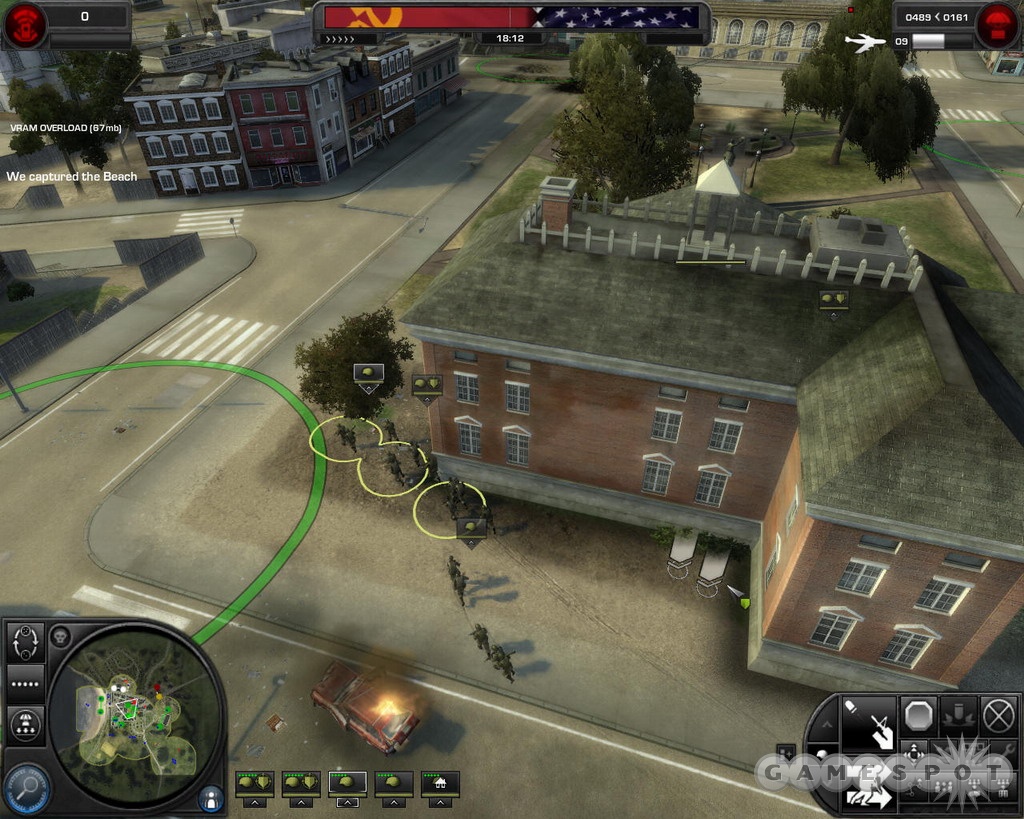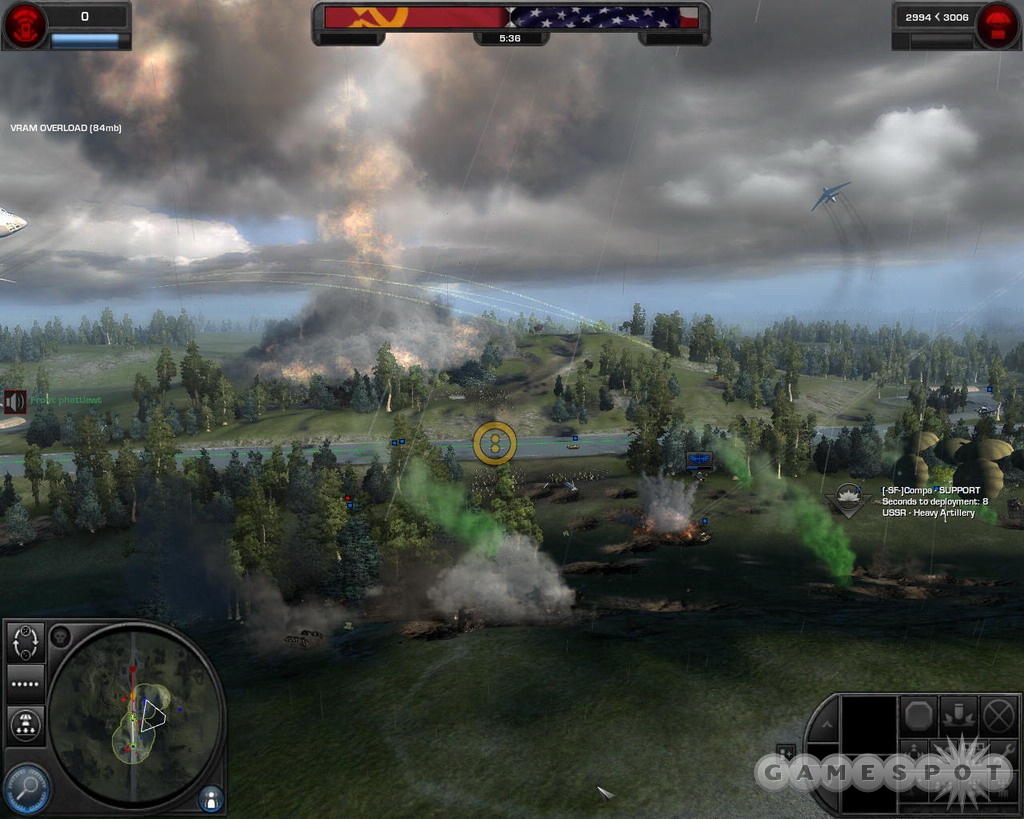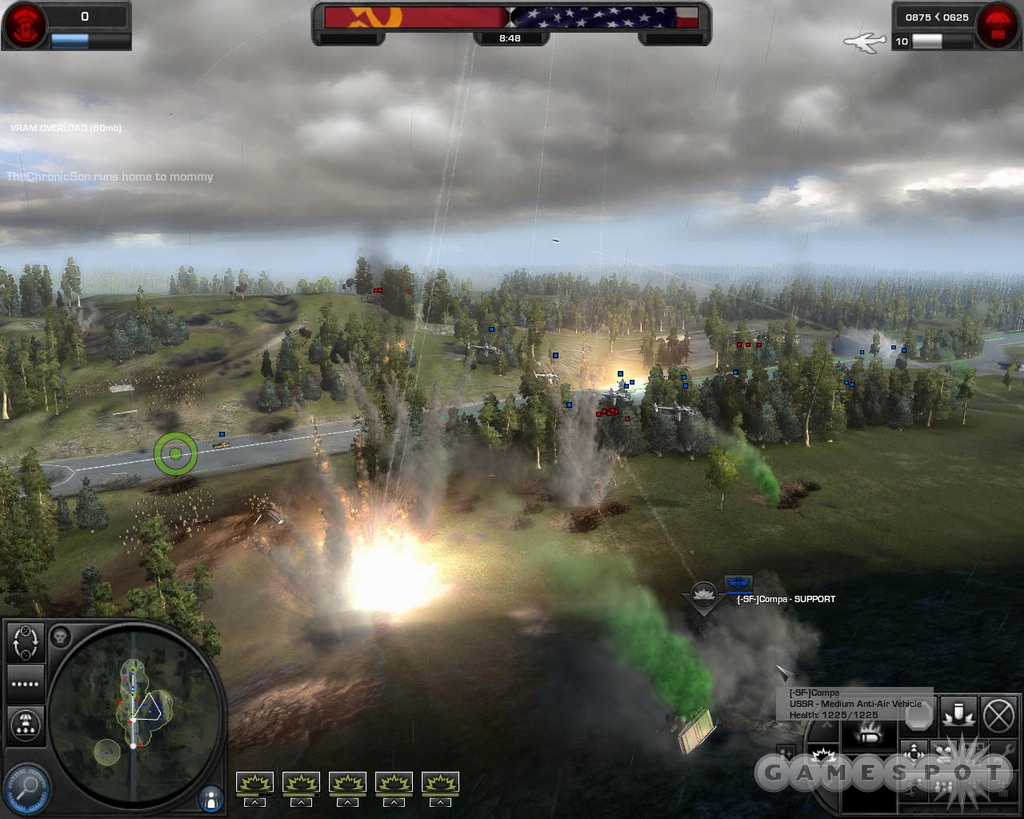World in Conflict Updated Multiplayer Hands-On
Sierra and Massive's World War III game will offer multiplayer that blends real-time strategy and action with heavy doses of teamwork.
Since the Cold War ended peacefully between the West and the Soviet Union, the epic conflict that both sides braced for never took place. However, armchair historians and fans of military games will be able to participate in a fictional World War III when the real-time strategy game World in Conflict arrives. We've been playing around with the beta-test version of the game, and World in Conflict has matured quite a bit since we played the very early work-in-progress version earlier this year.
World in Conflict is about World War III in the late 1980s as the Soviet Union and the West come to blows. This results in a Soviet invasion of the West Coast of the US, which is where the game is set. While the single-player campaign is played from the American perspective, you can play in multiplayer as the Soviet Union or NATO on European and Russian battlefields. Or you can play as the US or the USSR on American battlefields. However, instead of being a one-on-one style of multiplayer game, World in Conflict is about teams battling teams on huge battlefields. We've previously noted that World in Conflict's multiplayer feels a bit like a real-time strategy version of the popular Battlefield action games, and this impression remains very much intact.
The multiplayer gameplay is fun because you don't micromanage dozens upon dozens of units across the battlefield as you would in a standard real-time strategy game. Instead, you have a very specific role to play and only a handful of units to worry about, so this is very much a game about teamwork. For example, we suspect that newcomers will love the support (artillery) class because it's easy to pick up and fun to play. Whereas armor, infantry, and air can get chewed up quickly on the front lines, the artillery class can sit back in relative safety, pounding any point within its range. If you select a few of the heavy artillery pieces, you can rain death down at incredible distances. Because World in Conflict has built-in voice-chat support, you can hear your teammates making many artillery requests, so there's no shortage of targets. Artillery is so dangerous that it becomes imperative to take enemy artillery out. This can be done by sending in a scout helicopter to locate enemy artillery so you can call in an air strike or have your artillery take it out or by having ground units roam around the enemy's rear hunting for targets.
When you join a multiplayer game (there's no waiting in a lobby; if there's a slot open on a server, you'll directly enter a game midmission), you select which role you want to play on the battlefield. There's infantry, which lets you request and control infantry squads, antitank squads, or snipers. Infantry don't seem very sturdy on a battlefield full of tanks or nuclear missiles, but if you barricade them in buildings and forests, they become difficult to root out. Armor consists primarily of tanks and armored personnel carriers. As you can guess, they're powerful, but they're vulnerable to helicopters and infantry in tight quarters. Helicopters range from transports and scout helicopters to gunships. They can chew up armor, but they're very fragile to infantry armed with antiaircraft missiles and antiaircraft weapons. Then there's support, which consists primarily of artillery and antiaircraft platforms. These are powerful in their own right, but tanks, helicopters, and infantry can easily destroy them. As you can see, there's a rock-paper-scissors relationship because every combat arm has its distinct strengths and weaknesses.

Thankfully, the interface has been overhauled to make the game a lot more accessible. Before, it helped if you knew the difference between an M60 and an M1 to figure out what to requisition, but now there are simply three classes of units: light, medium, and heavy. For instance, light tanks are the cheapest but also the weakest; however, the advantage is that you can requisition a lot of them. Medium tanks are more powerful, but they're also pricier, so you get them in smaller numbers. Finally, heavy tanks are the monsters of the battlefield, but they're so expensive that can only have two or three of them at any one time. It's a logical system, and it eliminates the need to have an encyclopedic knowledge of 1980s military equipment to understand the game. This system also helps balance the game. Sure, there's a temptation to load up on the heaviest of units, but those are so expensive that you only get a handful of them. The best teams that we saw playing the beta had a mix of light, medium, and heavy units. For instance, a light scout helicopter is perfect for locating enemy positions, while a bunch of medium artillery can provide fire support much more rapidly than slower, heavier units. This sort of illustrates the conundrum that strategists faced in the Cold War. The Soviet Union had the bigger military, but the West had the more advanced military. So is quantity a quality? Or does quality offset quantity? The game is so well balanced that it really seems to depend on the tactics and coordination that your team exhibits.
The objectives in missions depend on the game mode, but generally, it's not enough to simply kill the enemy. After all, both sides can reinforce constantly. If your units are destroyed, their requisition points trickle back to your reinforcement pool, so you can simply order up new units. These units are then delivered seconds later from a huge, lumbering transport swooping low over the battlefield. Much of the time, the goal is to seize objectives on the map. If your team can seize and hold all of the objectives, the enemy is in deep trouble. But the great thing about this system is that each match remains fluid and exciting from start to finish. Players are constantly bringing in fresh units, trying new tactics, and fighting until the timer runs out on the mission.
Another cool aspect of World in Conflict is tactical aid. The more effective you are at killing the enemy, the more tactical aid points you accrue. You can use these points to requisition off-map support, such as artillery bombardments, air strikes from fighter bombers, air sweeps from air superiority fighters, and, yes, tactical nuclear missile strikes. A tactical aid can turn the tide of battle. Does the enemy have a swarm of attack helicopters chewing up your tanks? Then send in fighters to sweep them from the skies. Have you located a cluster of enemy artillery that's out of range of your own artillery? Send in fighter bombers to take them out. One of the neat things is that if your team is in trouble, you can send your tactical aid points to a teammate. So if your team desperately needs to call in a nuke, you can pool your points together to buy it.
Visually, the game remains impressive, and we were only running the DirectX 9 version of the game. World in Conflict will support DirectX 10 out of the box, so it should look even prettier if you have the hardware. Still, it's hard not to be amazed by the incredible amount of detail packed on the screen. You can watch the countryside being blown apart by nuclear explosions, artillery bombardments, air strikes, and more, and the level of destruction is immense. For example, nukes leave giant craters in the ground, artillery can explode buildings that infantry hide in, and entire forests can be leveled by fire.
World in Conflict doesn't play like a standard real-time strategy game, and it feels like a refreshing change of pace for the genre. There's such an emphasis on teamwork and tactics that its rewarding when you work together to defeat the enemy, but it's still fun if your team is being manhandled on the battlefield. It's also certainly a game to keep an eye on if you like military-themed games or intense multiplayer action. World in Conflict ships this fall.
Got a news tip or want to contact us directly? Email news@gamespot.com


Join the conversation